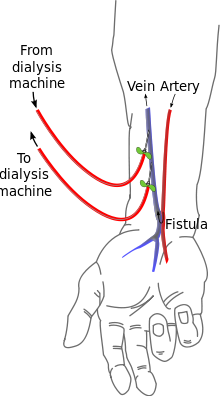Cimino shunt
A Cimino shunt , or Cimino-Brescia fistula, is a surgically created direct connection between an artery (usually radial artery ) and an adjacent or nearby vein (usually cephalic vein or mediana cubiti vein ). This shunt is used in chronic dialysis therapy , in which the patients are connected to the external blood filter machines via this shunt.
Operational approach
The most common location for applying the shunt is the distal, i.e. remote forearm. Before the operation, the vessels on both sides are checked by Doppler sonography and a recommendation is made.
The vessels are accessed through a skin incision of approx. 3–5 cm at the end of the forearm on the thumb side. Then the vein is first found and exposed, and then the artery is exposed. The vein must be detached from the surrounding connective tissue to such an extent that it can be transferred to the artery without tension. The vein is then clamped off, cut off at the distal end and rinsed with a heparin-saline solution. The artery is then clamped off and opened with a short longitudinal incision. The vein is then sutured onto the artery in an end-to-side anastomosis without twisting errors, i.e. without twisting the vein around its own axis, then the clamps of the vessels are released again. The vein should now quickly fill with arterial blood, which can be observed by a clear increase in lumen. You can feel a pulsating whirring sound with your finger. The anastomosis must be checked for possible leaks. Finally, the skin incision is sewn up again and the operated area is monitored with a stethoscope. You should hear a pulse-synchronized whirring.
Complications
In addition to errors in the operation itself, e.g. B. a rotation error, it can also lead to infections of the shunt area, thrombotic occlusions of the shunt and anastomotic leakages. Excessive stretching of the vein towards the upper arm, an aneurysm, also occurs.
Individual evidence
- ^ Michael Allon: Current Management of Vascular Access . In: Clinical Journal of the American Society of Nephrology . No. 2 , 2007, p. 786-800 ( Article ).
Web links
- National Kidney Foundation: Clinical Practice Guidelines for Vascular Access ( English ) 2006. Accessed August 3, 2018. guideline of the American Kidney Foundation
- Ivan D. Maya, Michael Allon: Vascular Access: Core Curriculum . In: American Journal of Kidney Diseases . No. 51 , 2008, p. 702–708 (English, article - summary of the current state of knowledge in key words).
- Guideline : Shunt Surgery , German Society for Vascular Surgery (online: full text, pdf ), status 03/2018

